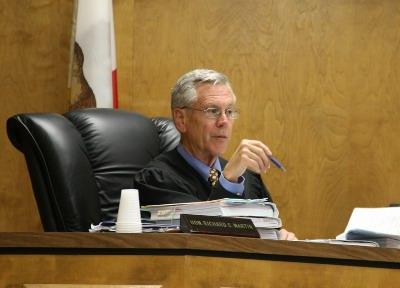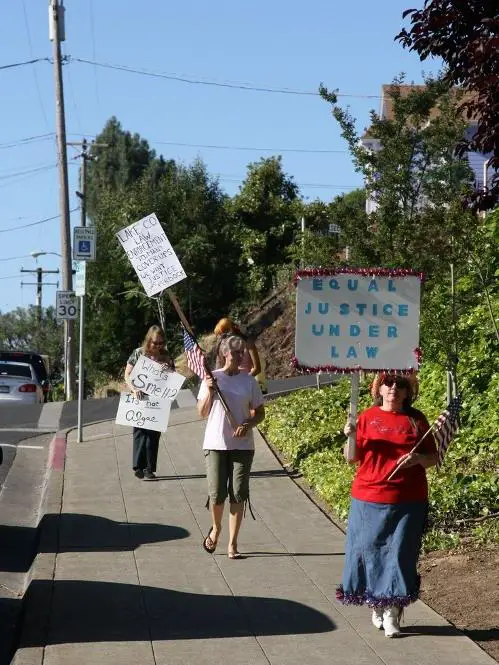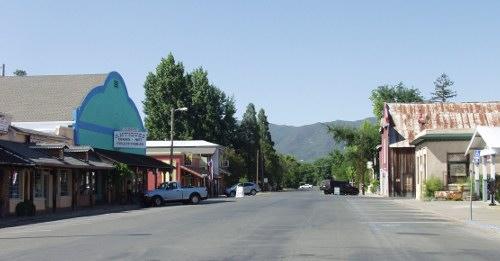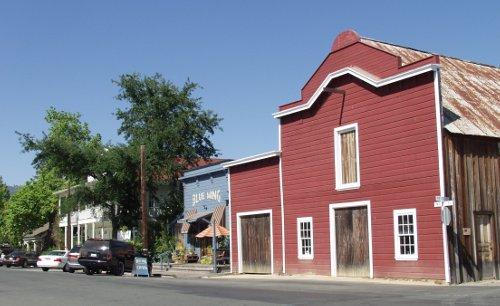
AltaRock Energy's drill rig on its pad, located above Middletown on land leased from the Bureau of Land Management by the Northern California Power Agency. The rig already has begun drilling in a 20-year-old well, and will begin fracturing bedrock in August 2009 in an effort to harness heat from deep within the earth. Photo courtesy of AltaRock.
This is the first of a two-part article on a new geothermal drilling project at The Geysers.
THE GEYSERS – In the coming months, a two-year project to test the viability of a developing geothermal technology will begin in The Geysers.
But while the technology is heralded by some in the geothermal industry as a promising new clean energy source, it's also known to cause sizable earthquakes at some of its test sites around the world.
That's raising concerns for the earthquake-prone Geysers area's residents, who already contend with small earthquakes on an almost daily basis.
AltaRock Energy, based in Sausalito and Seattle, is a venture capital company with $36 million in private investment and government funding which plans to try out its engineered geothermal system (EGS) at The Geysers.
The company will drill down thousands of feet and create fractures in bedrock, and then will inject water into those fractures in an effort to harness the heat deep in the earth to create steam for geothermal energy production.
Jeff Gospe, an Anderson Springs property owner and president of the Anderson Springs Community Alliance, has closely monitored seismic issues in the area over the years.
He said the community isn't against geothermal, but they feel AltaRock's project was rushed through a less-than-transparent process, that the company wasn't upfront about the problems inherent in EGS technology and that they ignored critical seismic data in their environmental assessment.
“It doesn't feel like a real honest process,” he said, adding that he wished there had been more study of the project.
Gospe said the geothermal industry is glossing over the fact that earthquake numbers near The Geysers are growing. There have been 360 earthquakes in the area this year alone, averaging about one a day that can be felt by residents. In addition, the numbers of earthquakes measuring 4.0 and above also are on the rise.
AltaRock Chief Executive Officer Don O'Shei and Senior Vice President Jim Turner said they wanted to work in The Geysers because it's the largest geothermal operation in the United States today, and has had a history of geothermal production going back to 1921.
Turner said The Geysers is operating at only half capacity, with some areas of its steamfield already depleted. It's also one of the best studied areas in the US, which helps their work since they'll know where the existing faults are located.
Murray Grande, geothermal facilities manager for the Northern California Power Agency (NCPA) – which owns and operates two geothermal power plants and a steamfield at The Geysers – said AltaRock has a two-year agreement with NCPA to conduct a demonstration project on its EGS technology.
NCPA's members include 15 municipalities and utilities around California, including Ukiah, Healdsburg and the Alameda Municipal Power. Lake County currently is not a member, although officials have mentioned joining the group, which benefits from local facilities.
AltaRock approached NCPA, said Grande, which agreed to let them use an unproductive well first drilled 20 years ago which since has been used for water injection. That well is located on property that NCPA leases from the Bureau of Land Management. The steam would be run to NCPA's power plant in order to generate electricity, Grande said.
The infrastructure is in place for work to begin immediately, said Turner. Using a drill rig that sits at an elevation of 3,150 feet and is visible on a hill above Middletown, AltaRock has begun drilling down 3,200 feet through the well's casing. O'Shei said drilling has taken place in the area in the past with no incident.
The EGS technology has raised concerns because of a 2006 incident in Basel, Switzerland, where it triggered a 3.4-magnitude earthquake and another 3,500 quakes over the following year, with millions of dollars in insurance claims paid out in Switzerland, France and Germany. AltaRock wasn't involved in that project, Turner and O'Shei emphasized.
They explained that Basel – which suffered severe damage in a 14th century earthquake – has a large fault running underneath it. The Basel project – which located the drill in the middle of the medieval town – drilled down directly into the existing fault and injected water into it. There were no fatalities or injuries, but the populace was badly shaken up by the incident.
Faults build up stress and then release, said O'Shei. Injecting water into the fault at Basel lubricated the fault and caused a slippage which, he noted, likely would have happened at some point anyway.
The Basel project made a number of mistakes that “we're not looking to repeat,” said O'Shei.
Another EGS project is taking place in Soultz-sous-Forêts, France, where large amounts of water are being injected into fractures five kilometers deep, according to the Geophysical Journal International.
The project – which isn't AltaRock's – involves three wells. Between 2000 and 2005, 700 seismic events of magnitude 1.0 to 2.9, the journal reported. One of the wells had a greater seismic response due to being closer to large faults.
The journal noted, “The future EGS programme will have to drill wells in zones free of large faults to avoid poor hydraulic performance and inconvenience to the population.”
AltaRock's environmental assessment notes that EGS sites in Australia and the United Kingdom also experienced earthquakes of 3.7 and 3.1, respectively.
Because NCPA is a public agency, the project went through a California Environmental Quality Review, said Grande.
Grande said a seismologist will be on site 24 hours a day, seven days a week, to monitor seismicity.
Mark Dellinger, administrator for Lake County Special Districts, is one of the county's most knowledgeable officials when it comes to geothermal, having worked for years on The Geysers pipeline.
He said AltaRock submitted permits that went through the Community Development Department for seismic monitoring. Because the project is located on a federal lease, Dellinger said he's not sure those county permits technically were needed.
“I think there needs to be mitigations, and I think there are adequate mitigations for this project,” said Dellinger.
He added, “Nobody knows what's going to happen,” but he thinks monitoring is going to help. “That's a very important thing.”
The benefits to NCPA are twofold, said Grande. First, if it works, they'll have access to a new heat source. Second, they could then purchase the steam from AltaRock, which will allow NCPA to generate more renewable geothermal energy.
Grande said EGS technology has the potential to expand geothermal productive to areas across the western United States that haven't been traditional geothermal production areas.
“There's a a huge potential to create many many megawatts of energy that would otherwise not be available,” he said.
Calpine, which is reportedly looking at expanding its Geysers operations, said it won't use the EGS technology.
“They're not planning any of these new techniques,” said company spokesman Jason Barnett.
However, Dennis Gilles, Calpine's senior vice president of renewables growth, explained that the corporation is doing “enhanced geothermal system” work – also known as “EGS.”
Enhanced geothermal involves going into an existing geothermal reservoir, like The Geysers, and injecting water into the existing cracks in the in the bedrock, which heats the water to steam and facilitates geothermal production.
Calpine has received Department of Energy grants for its geothermal projects in the past, Gilles said.
The public process is faulted, say neighbors
Turner said AltaRock officials began attending community meetings in Anderson Springs last October, which they plan to continue doing. They're also attending twice-yearly seismic monitoring council meetings. He said the company wants to be active in the community and responsive to its concerns.
Rich Eastabrook, a petroleum engineer with the Ukiah BLM office, said the lease for the land where AltaRock's project will take place has been in effect since the 1970s.
He said an environmental assessment process took place, in partnership with NCPA, which was the lead agency under CEQA.
AltaRock solicited geophysicists to complete the 218-page project review, available on its Web site (http://altarockenergy.com/media.html), about the possible impacts. That document used as a source data from the environmental impact report completed on The Geysers pipeline, Grande said.
“It was pretty well concluded that, yes, there are going to be some microearthquakes that are generated by this project, but the impact of those are going to be fairly insignificant compared to what already occurs at The Geysers,” Grande said. They're also confident they won't additionally impact the neighboring Anderson Springs community.
The assessment said the largest earthquake that's been attributed to EGS is 4.6 in magnitude, with quakes measuring less than 3 in magnitude expected to result from AltaRock's project.
But Gospe and fellow Anderson Springs residents believe the project's environmental assessment document has problems. They said it relies on outdated information and omits or ignores a lot of readily available seismic data provided by the US Geological Service and even the community itself at its Web site, www.andersonsprings.org .
Meriel Medrano, who said AltaRock's drill rig is located up the hill about a mile and a half from her home, called the environmental assessment “absolutely ridiculous.” It didn't include any of the 12 years of information collected by the county's seismic monitoring committee – which has been meeting since 1997, said Gospe – but instead used outdated materials.
Getting information about the project out to the public in the first place drew criticism from residents.
BLM put a small public hearing notice in the legals section of the local newspaper on March 25, said Medrano. That notice announced a public meeting on the evening of April 9 at the Calpine Visitor Center in Middletown, which the night of the meeting was moved to a nearby church.
The public comment period on the project lasted from March 19 through April 17, said Medrano.
She said “very few” local residents attended, estimating at most there were 10 of them there.
Anderson Springs resident Joan Clay said the community meeting was the first time the community really had heard about the project. She said no notices were mailed to the community. Gospe said the only notice they saw was mailed to the Anderson Springs Community Services District.
Eastabrook said copies of the draft environmental assessment were sent to residents in the impacted areas, but he added, “We kind of dropped the ball a little bit there.”
“They dropped it but good,” said Medrano.
He said BLM relied on a mailing list provided by a project consultant and NCPA. “It turns out the mailing list was not as inclusive as it should have been,” with some residents in the target area of Anderson Springs and Cobb not getting the information that they should have gotten.
“We take full responsibility for that,” he said.
Although the noticing technically met the legal requirements, Eastabrook said BLM wants to go beyond that. So when they found out some residents hadn't received the documents, they had the assessments shipped out immediately.
At the hour-and-a-half-long April 9 meeting, Gospe presented updated seismic information along with the community's concerns, and AltaRock made some responses. He said the company never disputed his facts, instead claiming that they had no bearing on the project.
A permit already has been issued to deepen the existing geothermal well where AltaRock plans to drill, said Eastabrook. BLM also will issue a federal “sundry” notice.
Said Medrano, “It was a fast shuffle. It really was. It was very unfair to the community.”
Eastabrook said the project will have “fairly strict” monitoring requirements. There will be seismic trigger points; if those are reached, the drilling would have to be curtailed or suspended.
Just what the trigger points are hasn't been stated specifically in terms of magnitude. However, it has been described in terms of the Modified Mercalli Intensity Scale.
Quakes at a level IV – which awaken people at night, are felt indoors by man during the day and have a sensation like a heavy truck striking a building would result in modifications, according to project documents. A level V – felt by nearly everyone, breaking some dishes and windows, and awaking most people at night – could shut the project down.
“Our role is going to be one of monitoring, inspection and enforcement,” said Eastabrook.
He explained that BLM is supposed to get daily reports on the drilling. If anything goes wrong, he said, “We will not hesitate to take appropriate enforcement action.”
AltaRock was straightforward in sharing seismic data with BLM, said Eastabrook.
However, “They never told us that the Basel project had been shut down because of the seismicity,” Eastabrook said.
In fact, a word search for “Basel” in the environmental assessment document finds only two passing references to Basel, with no discussion of that project's impacts.
As well, Gospe accused AltaRock of a coverup because, at the April 9 meeting, he said they sold it as a demonstration project that they had done before. The big quake and the thousands of smaller quakes in Basel were omitted, he said.
“I don't think that's a deal killer,” Eastabrook said of Basel, adding, “I would have liked to have known that.”
But O'Shei said Basel is well known in the geothermal industry, and they didn't hide that fact. “There's nothing secret about what happened in Basel.”
An updated version of AltaRock's report does incorporate information provided by Gospe and Anderson Springs community members.
In the next installment, a seismologist describes the layout and operations of the Geysers steamfields, AltaRock gets involved in the community and company officials describe interest in renewable energy.
E-mail Elizabeth Larson at This email address is being protected from spambots. You need JavaScript enabled to view it. .
Read the second part of this report here:
Company says proposed geothermal project holds promise for renewables
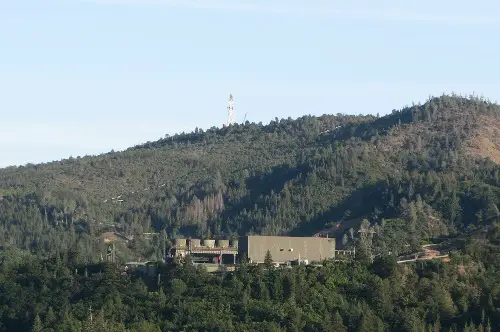
The AltaRock Energy derrick sits up high on a ridge at 3,150 feet. Photo courtesy of AltaRock.

 How to resolve AdBlock issue?
How to resolve AdBlock issue? 
